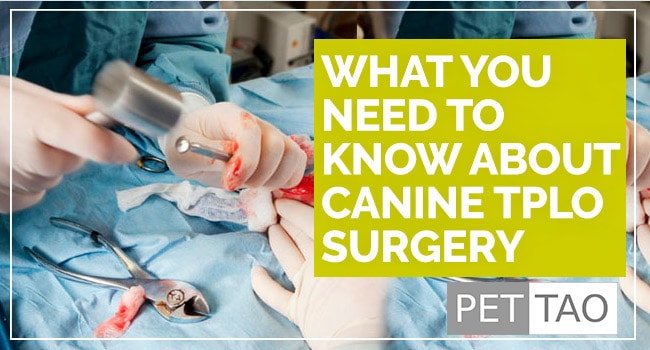Probably the most common surgery, and most recommended by surgical experts is the TPLO.
TPLO (Tibial Plateau Leveling Osteotomy)
TPLO (Tibial Plateau Leveling Osteotomy) is one of the most common surgeries and frequently recommended by board-certified veterinary surgeons.
Some people also call TPLO surgery“bone cutter”surgery.
During TPLO, the tibial plateau is cut in a circular fashion and rotated until it attains a relatively level orientation to the patellar ligament.
The cut places the tibial plateau at approximately a 90-degree angle to the patellar ligament.
The new orientation of the tibial plateau renders the knee relatively stable, independent of the role of the cranial cruciate ligament.
In fact, the cruciate ligament is no longer needed to stabilize the knee and many dogs continue to have cranial drawer signs even after a successful surgery.
The cut in the bone is stabilized by the use of a bone plate and screws.
Once the bone has healed, the bone plate and screws are not needed but are only removed if there is an associated problem.
A recent study demonstrated the superiority of the TPLO technique over suture stabilization in giant breeds of dogs.
What Happens After Surgery?
The following recommendations apply to both the TPLO and TTA.
After surgery, most dogs can go home the next day with pain meds and specific instructions.
Postoperative care must be followed diligently to avoid complications.
Immediately following surgery, incisional care is warranted, as well as the application of an E- collar.
Do not remove the E-collar because you feel sorry your dog has to wear one.
Everyone feels sorry for your dog; however, you must do what is in your dog’s best interest.
Removal of the E-collar can be disastrous as many dogs immediately begin to lick or scratch the incision leading to suture breakdown and infection.
Wearing the E-collar until suture removal is mandatory.
The incision will be on the inside of the leg.
Keeping the incision clean is necessary.
Use a warm semi-moist hand cloth to remove dried blood and any drainage.
Some veterinarians will bandage the leg after surgery. Each surgeon is different.
Applying ice packs to the leg 2-3 times daily for 10-15 minutes can decrease pain and swelling.
The sutures or staples should be removed in 10-14 days, and most dogs will be using the leg and ambulating fairly well.
Rehabilitation is Mandatory
However, you must follow instructions for rehabilitation.
Again, for emphasis:
It is mandatory that you follow the instructions for rehabilitation.
Since many dogs will be walking fairly normally 21 days after surgery, many owners assume their commitment to the success of the surgery is finished.
Do not let your dog’s ease of walking fool you!
The bone still has a long way to go in terms of healing.
Many catastrophic complications occur when owners fail to restrain their dogs properly and long enough to allow the bone to heal.
Dogs should be restrained on a leash for four months after surgery.
Leash restraint is non-negotiable.
When a TPLO surgery goes well, owners are very happy and dogs are too.
But when complications arise, it can be a nightmare.
The most common complications are the following:
- Swelling
- Bleeding
- Incisional infection
- Suture breakdown
However, more serious complications can include:
- Bone infection
- Plate failure
- Tibial fracture
- Cancer at the osteotomy site (rare).
In summary, TPLO to repair a torn cruciate ligament is a fantastic surgical procedure when all goes well.
But when complications arise, owners are often dejected and question their choice of TPLO.
Powerful Tools to Help Your Dog’s Ligament Challenges
There are many quick and easy changes you can make at home to help your give your dog an edge on easing tendon and ligament challenges.
- Llearn more about torn ligaments and cruciate disease.
- Provide joint support. PET | TAO’s Harmonize Joint is a blend of Eastern herbs and Western supplements working together to lubricate and restore your dog’s joints.
- Ease your dog’s discomfort naturally. PET | TAO’s Comfort is a blend of Eastern herbs and Western supplements to soothe your dog’s arthritic challenges to make him/her more comfortable.
- Try PET | TAO Freeze Dried Beef Liver Treats. According to TCVM, liver controls tendons and ligaments. As few as 5-6 treats per day can make a huge difference in your dog’s tendon and ligament health!
- Try a Blood-building TCVM Diet. PET | TAO Zing dog food builds Blood. According to TCVM, Blood deficiency leads to ligament tears.
- Learn more about TCVM Herbal Remedies. Chinese medicine offers many amazing natural solutions for ligament and cruciate challenges. Some good examples are:








